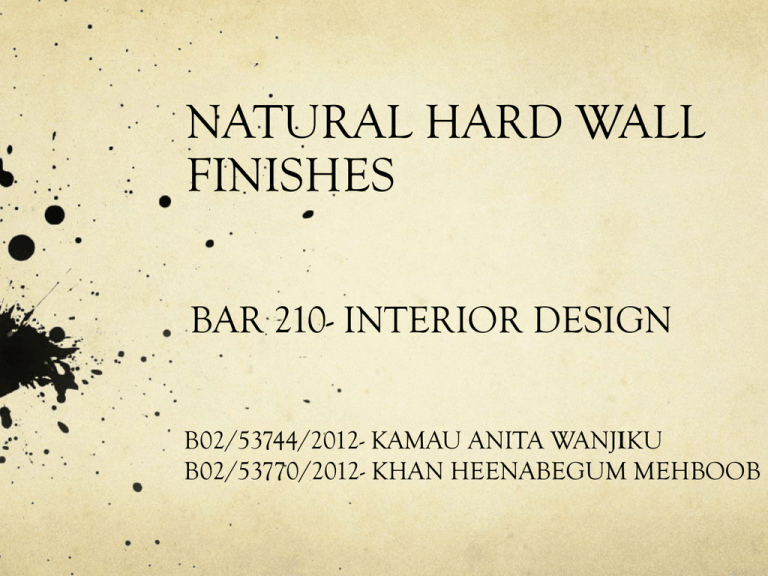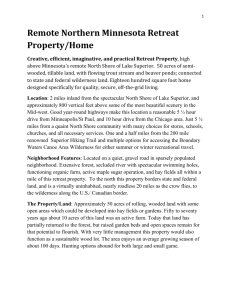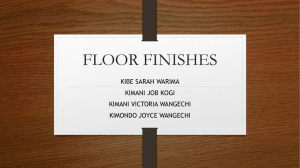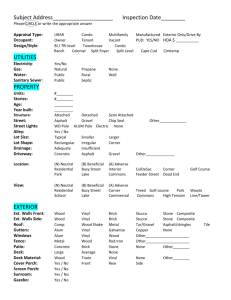Natural Hard Wall finishes
advertisement

NATURAL HARD WALL FINISHES BAR 210- INTERIOR DESIGN B02/53744/2012- KAMAU ANITA WANJIKU B02/53770/2012- KHAN HEENABEGUM MEHBOOB TYPES OF NATURAL, HARD WALL FINISHES Wood Metal Stone Concrete Tiles Terrazzo WOOD Renewable material which is easy to work Wood undergoes seasoning, surfacing and grading before it is used. Types of wood includes; 1. softwoods: pine, redwood, cedar. Softwoods have a simple microstructure, are course and their grain structure is uninteresting. The soft woods are inexpensive, plentiful and have a resistance to decay, they are used for paneling and moldings. 2. hardwoods : cherry, mahogany and oak. This woods have a more complex structure than softwoods and are mainly used for furniture and interior finish details Types of wood products Solid wood lumber; it is available in nominal or dimensional material. It is used for rough construction and framing. Laminated- wood products; they are several layers of wood glued together. They are used for structural or finish works. Veneers; this are thin sheets or leaves of woods produced by slicing a log, usually to maximize the utility of a piece of fine wood. Four primary veneer cuts includes: 1. Plain (flat) sliced- this is the most common cut 2. Rotary- most economical cut 3. Quarter Shawn 4. Rift cut Sources of wood In Africa Congo and Ghana Europe and North America: STONE Stone is used for its aesthetic appearance, durability and ease of maintenance. Types of stone includes; 1.Igneous Granites- are dense, hard, durable and susceptible to heat when exposed to fire hence are not used for interior structural applications. - Are fine or course grained - Shades: green, pink, yellow, white and black. - Finishes: polished, honed, flamed and hammered. - Used for wall cladding, table tops and flooring 2.Sedimentary Slate and lime stone - Tend to be soft and easily cleft and hammered. - are soft, brittle and splits easily into sheets. - colour range for slate: blue to orange. 3.Metamorphic rocks Marble- relatively hard but has a venal structure that is prone to fracture. - Porous and absorbs oils. - translucent and available in a wide range of colours. - Can be polished into shiny, smooth surfaces or honed to matte finish - used for decorative wall panels, table tops, fire places, counter tops and flooring. Sources of stone In Kenya Juja, Mazeras and Njiru, marble is mined at Mutini and limestone in Bamburi, Mombasa. The major source of slate stone is Spain METALS Metals are extremely durable material. Vary in relation to water, oils and chemicals. Can be drawn into wire, rolled into sheets, cast or stamped. Stainless steel and chrome resist most reactants encountered in interior environment, they are used in wet rooms and clean rooms. Brass and bronze are given a protective coat to prevent natural oxidation. Finish technology for metals include: hammering, brushing and polishing. Mostly used for ceiling, countertops, and at times on walls and other vertical surfaces. Sources 0f Metals -Sources of steel: Australia, China, Brazil, India, Russia, South Africa, Canada. -Sources of copper: Chile is the major producer of copper, in Africa Zambia is the leading producer followed by DR Congo, South Africa, Botswana, Namibia, Morocco, Tanzania. TERRAZZO Terrazzo is a matrix of marble, granite chips, cement, water or a synthetic resin. It is dense, extremely durable and smooth. Coloring is controlled by the size and color of aggregate and binder. Placed over a concrete over bed. Types of terrazzo: - Standard terrazzo- it has small chip sizes. - Venetian terrazzo- large chips with small chips as filters. - Paladin - Rustic terrazzo- uniformly textured finish in which the matrix is depressed, exposing the aggregates, not ground or polished. CONCRETE Extremely hard and resistant to weathering. Aggregate of sand or gravel and a binder-cement- which is mostly used. All this natural materials have to be mixed by man in order to be used. Concrete blocks are also used for wall interior finishes. TILES They are thin in relation to their facial area. Can be textured, smooth, embossed, patterned, sculptured, engraved, glazed or unglazed. CERAMIC TILES Advantages - Impervious. - Available in a wide variety of colours, sizes and finishes. - Extremely durable. Disadvantages - Expensive. - Brittle. - Requires extraordinary substrate. - Can be perceived as cold. Used in; clean areas, wet areas, high traffic areas. Sources around the world; China, Italy, Mexico, Canada and Spain. Flamingo tiles whose headquarters are in Nairobi produce tiles locally. Thank you











